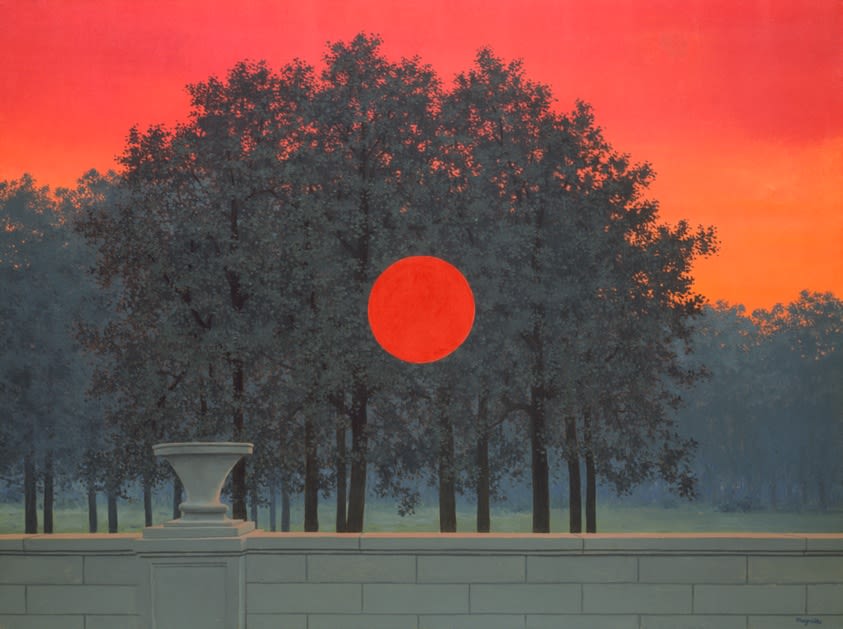In the Museum with Joann Yu
René Magritte, The Banquet, 1958

René Magritte, The Banquet, 1958.
René Magritte, The Banquet, 1958.
by Caitlin Cooner (MA 2025)
Rene Magritte’s 1958 painting, The Banquet, is a deviation from the typical fantastical, unsettling Surrealist painting; it captivates audiences with its glowing colors and serene setting.
The Banquet is part of a series of four landscape paintings by the artist. It depicts a vibrant sunset in a domesticated, rural environment with a stone parapet in the foreground and a forest of trees in the background. Its perspective places the viewer on the balcony, admiring the scene.
“This piece is a reminder of the aspiration of beauty as one of the rawest human desires. I adore it for its genuine power and ability and focus on simple, but profound philosophical discourse,” shared Joann Yu, a graduate student studying in the School of the Art Institute Chicago’s (SAIC) Writing program. Yu believes that Magritte’s The Banquet is an exceptional gateway into learning about art because its beauty allows the viewer to simply enjoy the work.
Although this painting is one of Magritte’s later works, it still engages with his familiar themes of visibility versus invisibility. Keeping with the traditional Surrealist notion of manipulating reality and creating dream-like scenes, this piece transforms traditional landscape paintings with the sun setting on top of the trees, rather than peeking through them, subverting expectations.
Yu encountered this piece during her first year as an undergraduate in the Art Education program at SAIC. She believes this painting could be used as an educational tool to teach people about Surrealism without involving the grotesque or sexist images that are common in this genre. Although it is important to talk about more serious concepts, Yu finds that enjoyment should be at the forefront of teaching audiences, especially children, about art.
Moving from art education into writing, Yu chose to continue learning at SAIC because she found a like-minded community of writers who are also interested in art. She enjoys writing because it allows her to cultivate her unique voice. Yu’s focus is short fiction; many of her stories play with fantasy and are inspired by her personal experience as an Asian woman and her observations about humanity. She also writes articles for the Art Institute’s Chinese media platform. Yu has written articles in Chinese about the Art Institute’s collection, including The Banquet, to make art more accessible to Chinese-speaking audiences.
Yu finds that writing about her experience of viewing art is the most compelling intersection of her two interests. “I found myself, sometimes, wanting to describe the moment when I encounter a piece of work or the physical feeling of walking in the museum or walking to an exhibition. Because I think, for some artworks, such as this one, you have to combine your real life physical experience to really feel the power within this piece of work,” she said.
Much like a painter manipulating a blank canvas, Yu likes manipulating various elements in her writing, making her work layered and complex. However, sometimes she likes to be reminded that impactful art can also be simply beautiful. She hopes that her writing will inspire readers like The Banquet has inspired her. ■
